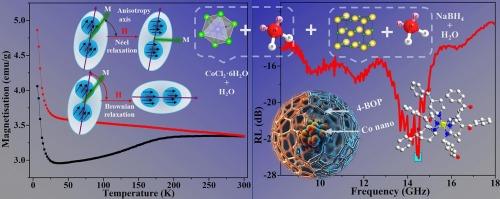A strategic chemical reduction method to stabilize ferromagnetic Co phase in 4-benzoyl pyridine and wideband microwave absorption through magnetic investigation
IF 4.6
3区 材料科学
Q2 MATERIALS SCIENCE, MULTIDISCIPLINARY
引用次数: 0
Abstract
In this work, a complete new strategic chemical reduction method is established to prepare and stabilize the ferromagnetic Co metal. X–ray diffractograms, High-resolution transmission electron microscopy and Raman spectroscopic analysis authenticate the pure crystallographic phase. Magnetic analysis confirmed the mixed phase of superparamagnetism (SPM) and ferromagnetism (FM) state and authorize the presence of magnetocrystalline anisotropy. Interestingly, Co-4-BOP exhibit the wide absorption bandwidth from 8.2 GHz to 18 GHz which covers the entire X and Ku bands. Origin of magnetic loss and conversion of EM wave energy to heat energy is explained by the Brownian and Néel motion in conjunction with rotation/fluctuation of SPM particles and ferromagnetic domain friction. Dielectric loss arises from both the conductivity loss and polarization loss. Intrinsic lattice plane defect in the pyridine ring of Co-4-BOP composite and interfacial polarization to the grain boundaries of various interfaces within the composite system influence the polarization loss.

采用化学还原法稳定4-苯甲酰基吡啶中铁磁Co相,并对其进行了宽带微波吸收研究
本文建立了一种全新的战略性化学还原法制备和稳定铁磁性钴金属的方法。x射线衍射图,高分辨率透射电子显微镜和拉曼光谱分析证实了纯晶体相。磁性分析证实了超顺磁性(SPM)和铁磁性(FM)态的混合相,并证实了磁晶各向异性的存在。有趣的是,Co-4-BOP表现出8.2 GHz至18 GHz的宽吸收带宽,覆盖了整个X和Ku波段。磁损失和电磁波能量转化为热能的原因是由布朗运动和纳姆运动结合SPM粒子的旋转/波动和铁磁域摩擦来解释的。介质损耗来源于电导率损耗和极化损耗。Co-4-BOP复合材料吡啶环的本征晶格面缺陷以及复合系统内各界面晶界的界面极化影响极化损耗。
本文章由计算机程序翻译,如有差异,请以英文原文为准。
求助全文
约1分钟内获得全文
求助全文
来源期刊

Materials Science and Engineering: B
工程技术-材料科学:综合
CiteScore
5.60
自引率
2.80%
发文量
481
审稿时长
3.5 months
期刊介绍:
The journal provides an international medium for the publication of theoretical and experimental studies and reviews related to the electronic, electrochemical, ionic, magnetic, optical, and biosensing properties of solid state materials in bulk, thin film and particulate forms. Papers dealing with synthesis, processing, characterization, structure, physical properties and computational aspects of nano-crystalline, crystalline, amorphous and glassy forms of ceramics, semiconductors, layered insertion compounds, low-dimensional compounds and systems, fast-ion conductors, polymers and dielectrics are viewed as suitable for publication. Articles focused on nano-structured aspects of these advanced solid-state materials will also be considered suitable.
 求助内容:
求助内容: 应助结果提醒方式:
应助结果提醒方式:


